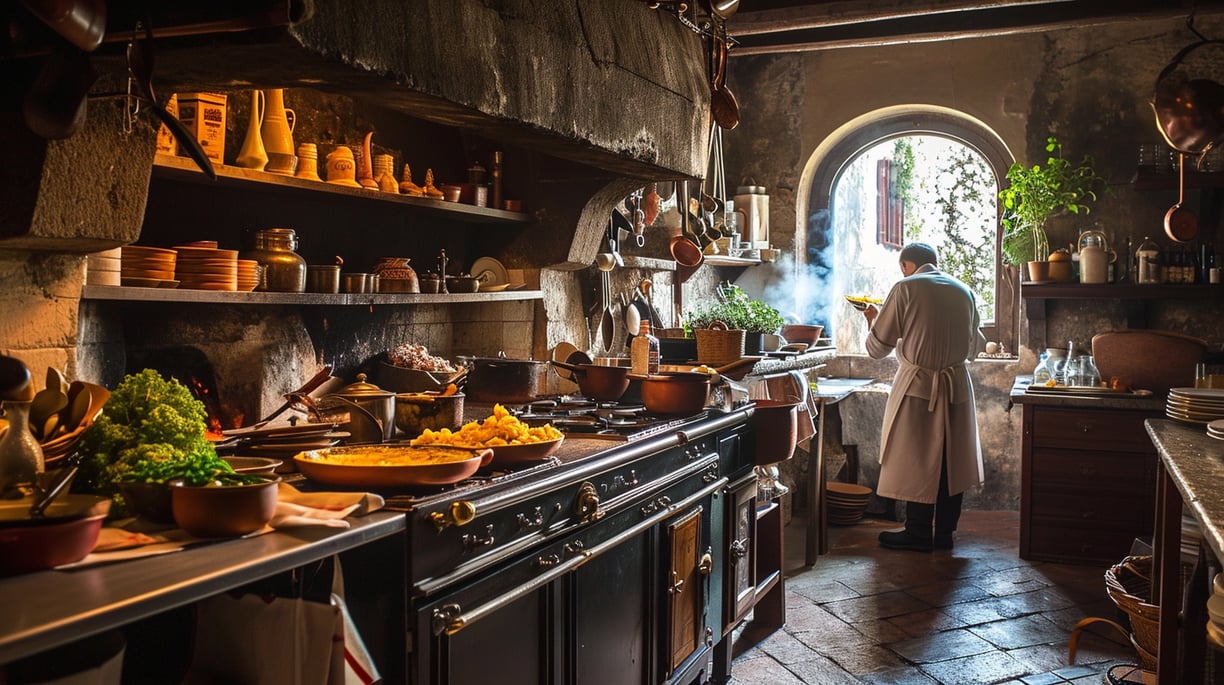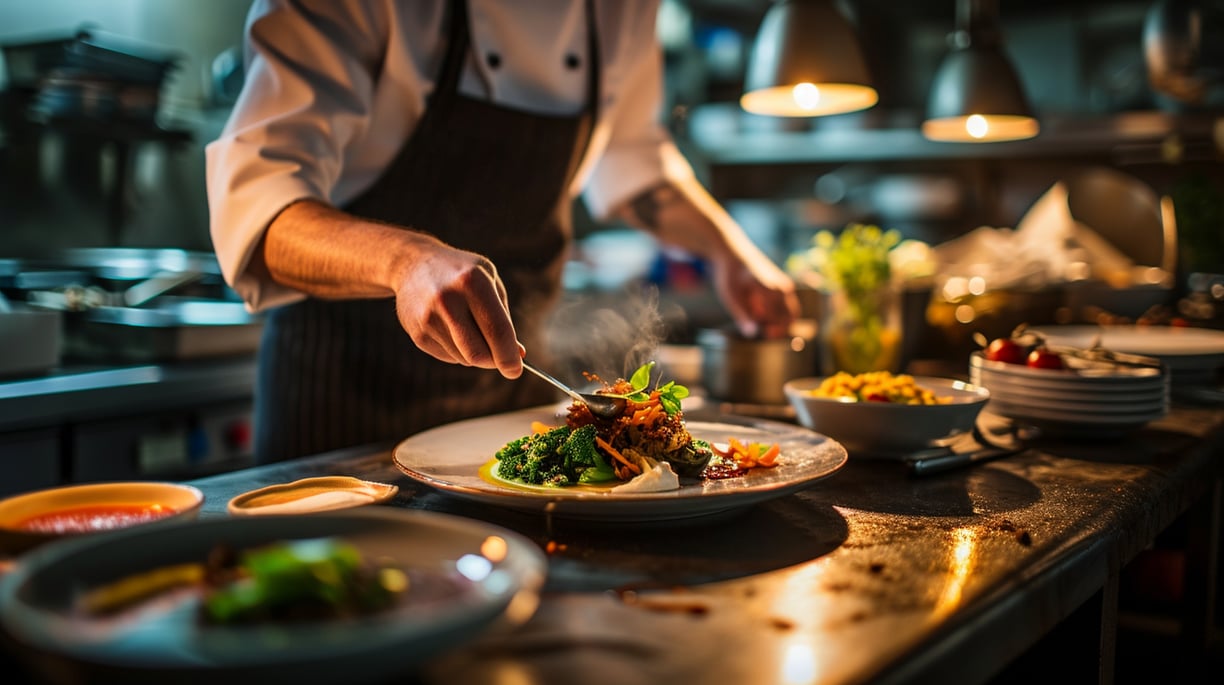The Evolution of Italian Cuisine: From Traditional to Modern
Explore the transformative journey of Italian cuisine, an adventure from time-honored traditional dishes to the innovative twists of modern cooking, reflecting Italy's rich culinary heritage adapting to contemporary tastes.

Italian cuisine is renowned worldwide for its delicious flavors and diverse ingredients. From pasta and pizza to risotto and gelato, Italian dishes have become staples in many households around the globe. But how did Italian cuisine evolve from traditional recipes to the modern culinary delights we enjoy today? In this article, we will explore the rich history and influences that shaped the evolution of Italian cuisine.
Understanding the Roots of Italian Cuisine
The Influence of Geography and Climate on Traditional Italian Food
Italy's unique geography and climate have played a significant role in shaping its traditional cuisine. The country boasts a varied landscape, with mountains, coasts, and plains, each providing distinct ingredients and culinary traditions.
In the north, regions like Lombardy and Piedmont are known for creamy risottos and hearty stews, influenced by their proximity to the Alps. The cold climate and fertile soil of these regions make them ideal for growing crops like rice and root vegetables, which are commonly used in their traditional dishes.
On the other hand, coastal regions like Liguria and Campania offer an abundance of seafood-based dishes, such as pasta with clams or Neapolitan pizza. The proximity to the Mediterranean Sea provides these regions with an abundant supply of fresh fish and shellfish, which are integral to their culinary heritage.
Furthermore, the Mediterranean climate of Italy creates the perfect conditions for growing fresh produce, such as tomatoes, olives, and herbs. The warm summers and mild winters allow these crops to flourish, and they form the foundation of many Italian dishes, contributing to their vibrant flavors.
The Role of History in Shaping Italian Culinary Traditions
Italy's rich history has also shaped its culinary traditions. Over the centuries, various civilizations and empires, including the Greeks, Romans, and Arabs, have conquered different parts of Italy, leaving behind their culinary influences.
The Romans, for instance, introduced staples like pasta and olive oil, both of which are integral to Italian cuisine. The cultivation of wheat and the invention of pasta-making techniques revolutionized the way Italians cooked and ate. Olive oil, with its versatility and health benefits, became a staple in Italian cooking, adding richness and depth of flavor to many dishes.
Arab traders brought spices, citrus fruits, and rice, leading to the creation of unique dishes such as Sicilian arancini and citrus-infused desserts. The Arab influence is particularly strong in southern Italy, where the use of spices and exotic ingredients adds a distinct flavor profile to the local cuisine.
Moreover, Italian cuisine evolved further during the Renaissance, as wealthy Italian families and city-states competed to impress their guests with extravagant banquets. It was during this period that pasta, previously reserved for the lower classes, gained popularity among the upper classes and became a symbol of Italian culinary excellence. The Renaissance also saw the rise of renowned Italian chefs and the publication of influential cookbooks that documented and codified Italian culinary traditions.
The roots of Italian cuisine run deep, intertwining geography, climate, and history to create a diverse and flavorful culinary heritage. From the snowy peaks of the Alps to the sun-drenched shores of the Mediterranean, each region of Italy has its own unique culinary traditions, reflecting the bounty of the land and the influence of past civilizations. Exploring Italian cuisine is not only a journey through taste but also a journey through time, uncovering the stories and flavors that have shaped this beloved cuisine.

The Transition Period: Merging Old with New
The Introduction of New World Ingredients
During the Age of Exploration, Italian cuisine experienced a significant transformation with the introduction of new ingredients from the Americas. Tomatoes, potatoes, and maize became integral parts of Italian cooking, leading to the creation of iconic dishes such as tomato-based pasta sauces and gnocchi.
Italian chefs and home cooks embraced these new ingredients, incorporating them into traditional recipes and experimenting with new flavor combinations. The vibrant red color and tangy taste of tomatoes brought a refreshing twist to pasta dishes, while the starchy goodness of potatoes added depth to soups and stews. Maize, with its versatility, was used to create polenta, a popular dish in Northern Italy.
The introduction of these New World ingredients not only expanded the culinary repertoire of Italians but also influenced the way they approached food. The blending of Old and New World flavors became a hallmark of Italian cuisine, showcasing the adaptability and creativity of Italian cooks.
The Impact of Industrialization on Italian Cooking
The industrial revolution also had a profound impact on Italian cuisine. As urbanization and mass production took hold, traditional cooking techniques gave way to more convenient and efficient methods.
Canned tomatoes and preserved vegetables became widely available, allowing Italians to create their favorite dishes year-round. The convenience of having these ingredients readily accessible meant that families could enjoy the flavors of summer even during the colder months. Additionally, the ability to preserve vegetables ensured that nothing went to waste, promoting sustainability in Italian kitchens.
Moreover, the rise of pasta factories enabled the mass production of dried pasta, making it accessible to people of all socioeconomic backgrounds. Previously, pasta had been a labor-intensive dish, requiring hours of kneading and rolling. With the advent of pasta factories, this time-consuming process was streamlined, making pasta a staple in households across Italy.
However, the benefits of industrialization came at a cost. Traditional cooking methods were slowly being forgotten, and the quality of some ingredients suffered as mass production prioritized efficiency above all else. The art of making pasta from scratch or slow-cooking a sauce for hours became less common as people sought quick and easy meals.
Despite these changes, Italian cuisine continued to evolve, with chefs and home cooks finding ways to preserve traditional flavors while embracing the convenience of modernity. The transition period marked a turning point in Italian cooking, as it merged the old with the new, creating a culinary landscape that is rich in history, innovation, and delicious flavors.

Modern Italian Cuisine: A Blend of Tradition and Innovation
Italian cuisine has long been celebrated for its rich flavors, fresh ingredients, and time-honored traditions. However, in recent years, it has undergone a culinary renaissance, embracing a fusion of traditional elements with modern and international influences. Renowned chefs and food enthusiasts have pushed the boundaries of Italian cooking, resulting in innovative and exciting dishes that captivate the senses.
By incorporating ingredients from different cuisines and experimenting with flavors, these chefs have created unique meals that reflect both tradition and the evolving tastes of contemporary palates. Imagine savoring a plate of homemade pasta infused with aromatic spices from the Middle East or indulging in a pizza topped with a tantalizing blend of Asian-inspired ingredients. These fusion dishes not only pay homage to Italy's culinary heritage but also celebrate the diversity and creativity of the global gastronomic scene.
The Rise of Fusion and Experimental Italian Dishes
One of the most fascinating aspects of modern Italian cuisine is the rise of fusion and experimental dishes. Chefs are no longer confined to traditional recipes but are encouraged to explore new combinations and techniques. This culinary revolution has given birth to a myriad of exciting flavors and textures that captivate the taste buds.
Picture a dish where the delicate sweetness of fresh Italian tomatoes is enhanced by the umami flavors of miso, a staple in Japanese cuisine. Or imagine savoring a risotto infused with the smoky richness of Mexican chipotle peppers, creating a harmonious blend of Italian and Latin American flavors. These innovative creations not only showcase the versatility of Italian ingredients but also highlight the endless possibilities that arise when culinary boundaries are pushed.
The Influence of Globalization on Italian Food Culture
Globalization has also had a significant impact on Italian food culture. The increasing interconnectedness of the world has allowed for the global exchange of ingredients, cooking techniques, and culinary ideas. Italian chefs are now drawing inspiration from cuisines around the world, incorporating elements of Asian, Middle Eastern, and South American cooking into their dishes.
This cross-cultural exchange has not only enriched Italian cuisine but has also broadened its appeal to a global audience. Imagine relishing a plate of spaghetti carbonara infused with the vibrant spices of Indian curry or savoring a creamy tiramisu with a hint of aromatic cardamom. These innovative twists on classic Italian dishes not only showcase the adaptability of Italian cuisine but also celebrate the diversity and interconnectedness of our modern world.
As Italian cuisine continues to evolve and embrace new influences, it remains deeply rooted in tradition. The passion and dedication of Italian chefs to preserve the essence of their culinary heritage while embracing innovation is what makes modern Italian cuisine truly exceptional. So, whether you find yourself in a traditional trattoria or a cutting-edge restaurant, be prepared to embark on a gastronomic journey that seamlessly blends the past and the present, tradition and innovation.
The Future of Italian Cuisine
The Role of Sustainability and Local Sourcing in Contemporary Italian Cooking
In recent years, there has been a growing emphasis on sustainability and local sourcing in Italian cooking. Chefs and home cooks alike are recognizing the importance of supporting local farmers and preserving traditional farming practices.
By using seasonal and locally sourced ingredients, Italian cuisine can maintain its authenticity while also contributing to a more sustainable food system. This approach ensures that future generations can continue to enjoy the flavors and traditions that define Italian cuisine.
The Impact of Technological Advancements on Italian Cuisine
Technological advancements are revolutionizing the way we cook and experience food, and Italian cuisine is no exception. From precision cooking techniques to innovative kitchen gadgets, technology is allowing chefs and home cooks to explore new possibilities in the kitchen.
As technology continues to evolve, we can expect Italian cuisine to be at the forefront of culinary innovation, blending tradition with cutting-edge techniques to create unforgettable dining experiences.
Conclusion
The evolution of Italian cuisine from traditional to modern has been a fascinating journey, influenced by geography, history, and the changing tastes of society. Today, Italian cuisine continues to captivate the world with its rich flavors and diverse dishes.